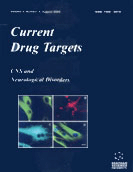Abstract
Poly(ADP-ribose) polymerase 1 (PARP-1) protects the genome by functioning in the DNA damage surveillance network. In response to stresses that are toxic to the genome, PARP-1 activity increases substantially, an event that appears crucial for maintaining genomic integrity. Massive PARP-1 activation, however, can deplete the cell of NAD+ and ATP, ultimately leading to energy failure and cell death. The discovery that cell death may be suppressed by PARP inhibitors or by deletion of the parp-1 gene has prompted a great deal of interest in the process of poly(ADP-ribosyl)ation. Suppression of PARP-1 is capable of protecting against cerebral and cardiac ischemia, 1-methyl-4-phenyl-1,2,3,6-tetrahydropyridine-induced parkinsonism, traumatic spinal cord injury, and streptozotocin-induced diabetes. The secondary damage of initially surviving neurons in brain stroke accounts for most of the volume of the infarcted area and the subsequent loss of brain function. Microglial migration is strongly controlled in living brain tissue by expression of the integrin CD11a, which is regulated in turn by PARP-1, proposing that PARP-1 downregulation may therefore be a promising strategy in protecting neurons from this secondary damage, as well. As PARP-1 is now recognised as playing a role also in the regulation of gene transcription, this further increases the intricacy of poly(ADP-ribosyl)ation in the control of cell homeostasis and challenges the notion that energy collapse is the sole mechanism by which poly(ADP-ribose) formation contributes to cell death. PARP(s) might regulate cell fate as essential modulators of death and survival transcriptional programs with relation to NF-κB and p53, proposing that inhibitors of poly(ADP-ribosyl)ation could therefore prevent the deleterious consequences of neuroinflammation by reducing NF-κB activity.
Keywords: poly(adp-ribose) polymerase, dna repair, neurotoxicity, brain ischemia, neurodegeneration, neuroinflammation, neuroprotection, gene transcription
Current Drug Targets - CNS & Neurological Disorders
Title: Poly(ADP-Ribosyl)ation Enzyme-1 as a Target for Neuroprotection in Acute Central Nervous System Injury
Volume: 2 Issue: 5
Author(s): S. D. Skaper
Affiliation:
Keywords: poly(adp-ribose) polymerase, dna repair, neurotoxicity, brain ischemia, neurodegeneration, neuroinflammation, neuroprotection, gene transcription
Abstract: Poly(ADP-ribose) polymerase 1 (PARP-1) protects the genome by functioning in the DNA damage surveillance network. In response to stresses that are toxic to the genome, PARP-1 activity increases substantially, an event that appears crucial for maintaining genomic integrity. Massive PARP-1 activation, however, can deplete the cell of NAD+ and ATP, ultimately leading to energy failure and cell death. The discovery that cell death may be suppressed by PARP inhibitors or by deletion of the parp-1 gene has prompted a great deal of interest in the process of poly(ADP-ribosyl)ation. Suppression of PARP-1 is capable of protecting against cerebral and cardiac ischemia, 1-methyl-4-phenyl-1,2,3,6-tetrahydropyridine-induced parkinsonism, traumatic spinal cord injury, and streptozotocin-induced diabetes. The secondary damage of initially surviving neurons in brain stroke accounts for most of the volume of the infarcted area and the subsequent loss of brain function. Microglial migration is strongly controlled in living brain tissue by expression of the integrin CD11a, which is regulated in turn by PARP-1, proposing that PARP-1 downregulation may therefore be a promising strategy in protecting neurons from this secondary damage, as well. As PARP-1 is now recognised as playing a role also in the regulation of gene transcription, this further increases the intricacy of poly(ADP-ribosyl)ation in the control of cell homeostasis and challenges the notion that energy collapse is the sole mechanism by which poly(ADP-ribose) formation contributes to cell death. PARP(s) might regulate cell fate as essential modulators of death and survival transcriptional programs with relation to NF-κB and p53, proposing that inhibitors of poly(ADP-ribosyl)ation could therefore prevent the deleterious consequences of neuroinflammation by reducing NF-κB activity.
Export Options
About this article
Cite this article as:
Skaper D. S., Poly(ADP-Ribosyl)ation Enzyme-1 as a Target for Neuroprotection in Acute Central Nervous System Injury, Current Drug Targets - CNS & Neurological Disorders 2003; 2 (5) . https://dx.doi.org/10.2174/1568007033482733
| DOI https://dx.doi.org/10.2174/1568007033482733 |
Print ISSN 1568-007X |
| Publisher Name Bentham Science Publisher |
Online ISSN 1568-007X |
 3
3Related Articles
-
An Osteoblastic Inflammatory Redox Model, using TNF-a, Glucose and Glucose- Oxidized Low- Density Lipoprotein: Targets for Minocycline
Clinical Immunology, Endocrine & Metabolic Drugs (Discontinued) Mesenchymal Stem Cells as Mediators of Neural Differentiation
Current Stem Cell Research & Therapy Resident and Non-Resident Stem Cells in Acute Myocardial Infarction
Cardiovascular & Hematological Disorders-Drug Targets Immunologic Modulations to Enhance Post-Stroke Recovery
Current Immunology Reviews (Discontinued) Simulated Microgravity Based Stem Cell Cultures Enhance Their Utility for Cell-Based Therapy
Current Biotechnology A Review of the Physiological Factors Associated with Alcohol Hangover
Current Drug Abuse Reviews Adult Neurogenesis and Parkinsons Disease
CNS & Neurological Disorders - Drug Targets Editorial [Hot Topic: Recent Perspectives on Nanoneuroprotection & Nanoneurotoxicity (Guest Editors: Hari Shanker Sharma and Aruna Sharma)]
CNS & Neurological Disorders - Drug Targets Ultrasound Imaging of Muscle-tendon Architecture in Neurological Disease: Theoretical Basis and Clinical Applications
Current Medical Imaging Cannabinoid 1 (CB1) Receptor - Pharmacology, Role in Pain and Recent Developments in Emerging CB1 Agonists
CNS & Neurological Disorders - Drug Targets Alcoholic Neuropathy: Involvement of Multifaceted Signalling Mechanisms
Current Molecular Pharmacology Pharmacotherpy and Alzheimer’s Disease: The M-Drugs (Melatonin, Minocycline, Modafinil, and Memantine) Approach
Current Pharmaceutical Design Disease-Related Changes in TRPV1 Expression and Its Implications for Drug Development
Current Topics in Medicinal Chemistry Bone Morphogenetic Protein-Smad Pathway as Drug Targets for Osteoporosis and Cancer Therapy
Endocrine, Metabolic & Immune Disorders - Drug Targets Cytokine and Immune System Abnormalities in Fibromyalgia and Other Central Sensitivity Syndromes
Current Rheumatology Reviews A Friend in Need May Not be a Friend Indeed: Role of Microglia in Neurodegenerative Diseases
CNS & Neurological Disorders - Drug Targets The Role of Brain Cholesterol and its Oxidized Products in Alzheimer's Disease
Current Alzheimer Research A Review on the Arylpiperazine Derivatives as Potential Therapeutics for the Treatment of Various Neurological Disorders
Current Drug Targets Patents on Non-Viral Mediated Gene Delivery
Recent Patents on DNA & Gene Sequences Neuroprotective Gene Therapy for Parkinson’s Disease
Current Gene Therapy


















